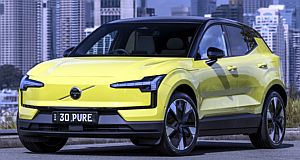Overview
VOLVO is on to a winner with the all-new EX30 compact crossover EV, which forms the basis for the Swedish brand’s EV model line-up.
Sourced from China and with a sub-$60K starting price, the marque expects this model will account for 3900 sales by the end of 2024 – possibly becoming the best-seller, as a result. Before the car had even arrived on our shores, Volvo Car Australia had sold 1500 units.
The model range is fairly simple, with a three-tier line-up kicking off with the base model Single Motor Plus, at $59,990 +ORCs, while the more richly specified Single Motor Ultra pushes the price up to $66,290 +ORCs, and the ballistic Twin Motor Performance coming in at $71,290 +ORCs.
All versions come with a 69kWh nickel manganese cobalt battery pack, with the Geely-platform-derived electric model offering 11kW AC charging capability, and 153kW DC charging. Neither of those numbers are class-leading, but they are competitive for an EV at this price point.
Recharging on maximum AC power should take 8 hours from 0-100 per cent, while DC max-rate charging should accomplish 10-80 per cent in 26 minutes. Driving range is around 480km WLTP for the Single Motor versions, and 460km WLTP for the Twin Motor.
On price, the EX30 line-up easily undercuts EV rivals from luxury brands such as Lexus (UX300e from $80,720 +ORCs), Mercedes-Benz (EQA from $84,900 +ORCs), Audi Q4 e-tron (from $88,300 +ORCs) and BMW iX1 (from $78,900 +ORCs).
In fact, the alternatives that are closer on price include the Cupra Born (from $59,990 +ORCs) and the Mini Countryman E (from $64,990 +ORCs).
The two entry grades are rear-wheel drive, with a single 200kW/343Nm electric motor and single-speed transmission taking care of momentum, and with a 0-100km/h claim of 5.3 seconds. Twin Motor Performance models live up to the nomenclature with 315kW and 543Nm, and a 0-100km/h acceleration time of just 3.6 seconds.
Standard specification for the base grade Single Motor Plus includes LED lighting, 19-inch alloy wheels, a two-tone roof (all grades have a choice of five colours), an electric tailgate, auto-dimming mirrors, a 12.3-inch touchscreen media system employing Google technology and connected services, wireless Apple CarPlay and Android Auto, wireless phone charging, two-zone climate control, and a leather-free interior that makes use of recycled materials.
There’s also a digital (smartphone) key if needed, plus a Harman/Kardon premium sound system.
Step up to the Ultra or Twin Motor Performance spec and your extra outlay adds items such as 20-inch alloy wheels, a fixed panoramic roof, tinted rear windows, heated and powered front seats with four-way lumbar adjustment, a heated steering wheel, a 360-degree surround-view camera and semi-autonomous parking technology.
Obviously, the flagship also adds AWD and heaps more performance.
The interior of the EX30 is stunning, but simple. It might not be as ‘luxury’ as some traditionalists might demand, with not a skerrick of leather trim to be seen. Instead, there’s an abundance of recycled stuff, and the fake-leather parts in the high-spec, while nice, cannot compete with the lovely cloth finish on the base versions.
The media screen takes some learning, and there’s no dials or buttons, which is annoying. But with time you’ll get to grips with the menus and so forth, but some may not be as agreeable about the lack of any driver instrument cluster – the speedo shows up in the top right corner, as in a Tesla.
The rear seat experience is lacking somewhat for a bigger body, with my 182cm frame feeling decidedly squished in the back row. It’s a tiny car, though, at just over 4.2m long, so that’s not a huge surprise. Though it is odd that Volvo didn’t fit rear directional air-vents to this car, as it does limit the niceness factor for families. If that’s not a dealbreaker for you, there are ISOFIX points in the window seats and top-tethers, too.
Boot space is only okay, at 318 litres, but there’s a false floor for a bit of extra flexibility, and a seven-litre frunk storage section, too. No spare tyre, though.
The EX30 comes with a five-year/unlimited-kilometre warranty, with an eight-year warranty for the battery pack. There’s also eight years of roadside assistance included, and five years of free servicing as well. Service intervals are 24 months/30,000km.
Driving impressions
It’s a sweet small EV drive experience for the most part. There’s arguably more than enough power and torque across the range, and the Twin Motor model is positively muscly in terms of its acceleration.
Of course, it’s smooth and simple to drive, with decent levels of refinement on offer; it’s even relatively quiet on coarser road surfaces with the 20-inch wheel package offered on high-spec models.
The steering is configurable with three different settings, though I found the middle ground to be the best compromise, especially at open road speed. Typically, it has pretty direct and responsive steering.
The ride is perhaps the questionable point for this car. It’s not a performance model, and even the Performance model doesn’t have a distinct suspension setup, which is perhaps to its detriment.
It can feel flummoxed by sudden bumps at higher speeds, particularly at the rear axle, but is mostly agreeable in urban driving.
The braking response is also pretty positive, but there’s no ‘proper’ single-pedal driving mode. It will slow down significantly using those regen brakes but doesn’t come to a complete halt like some rivals.
Overall, it is a fun and characterful drive, though this tester found the Single Motor version to be the sweeter drive for the daily duties’ buyer.



